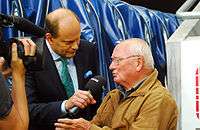Kurt Hamrin
|
Kurt Hamrin in 1970 | |||
| Personal information | |||
|---|---|---|---|
| Full name | Kurt Roland Hamrin | ||
| Date of birth | 19 November 1934 | ||
| Place of birth | Stockholm, Sweden | ||
| Height | 1.70 m (5 ft 7 in) | ||
| Playing position | Winger | ||
| Youth career | |||
| 1946–1947 | Huvudsta IS | ||
| 1947–1948 | Råsunda IS | ||
| 1949–1951 | AIK | ||
| Senior career* | |||
| Years | Team | Apps | (Gls) |
| 1952–1955 | AIK | 62 | (54) |
| 1956–1957 | Juventus | 23 | (8) |
| 1957–1958 | Padova | 30 | (20) |
| 1958–1967 | Fiorentina | 289 | (150) |
| 1967–1969 | A.C. Milan | 36 | (9) |
| 1969–1971 | Napoli | 22 | (3) |
| 1971–1972 | IFK Stockholm | 10 | (5) |
| Total | 472 | (249) | |
| National team | |||
| 1953–1965 | Sweden | 32 | (17) |
|
* Senior club appearances and goals counted for the domestic league only. | |||
Kurt Roland Hamrin (Swedish: [kɵʈ hamˈriːn]; born 19 November 1934) is a Swedish retired footballer. He is currently the eighth highest goalscorer of all-time in Italy's Serie A, with 190 goals. Hamrin was a fast, creative, and technically gifted winger; he was known in particular for his incredible dribbling ability with both feet, and for being prolific in front of goal. In addition to his success at club level, Hamrin also had a successful international career, and was a member of the Swedish team that reached the 1958 FIFA World Cup Final on home soil; he is commonly regarded as one of the greatest Swedish footballers of all-time.[1]
Career
Hamrin first played for AIK in Sweden, whom he joined in the 1952–53 season. He then joined Juventus in 1956 and played 23 games during his single season there. After that one season, he joined Padova on loan, where he scored 20 goals in 30 games. He would only stay there for one season again, however, as he was sold to Fiorentina in 1958, where he stayed until 1967, playing 289 Serie A games and scoring 150 goals. While at Fiorentina, he won the Coppa Italia in 1961 and 1966. Hamrin is commonly regarded as one of Fiorentina's greatest ever players. He joined A.C. Milan in 1967 and played there for two seasons, winning the league in 1968. He also scored both goals for Milan as they overcame Hamburg 2–0 in the 1968 European Cup Winners' Cup Final. His final Italian club was Napoli, whom he joined from Milan in 1969. In 1971 he return to Sweden, playing one season for IFK Stockholm before retiring in 1972.

A member of "Exilgnagare" – a club for AIK supporters worldwide, Hamrin is probably one of the finest players the club ever produced and is still a big favourite among the supporters at the club. Hamrin, settled in Florence after his spell at Fiorentina, still follows his beloved AIK and usually makes the trip home every summer to catch a couple of games.
Hamrin played 32 times for Sweden between 1953 and 1965, scoring 17 goals. Most Swedes remember him best for the goal he scored against West Germany in the semi finals of the World Championships of 1958. The goal meant 3–1 to Sweden, and secured a place in the final against Brazil for Sweden.
After his retirement as a footballer, Hamrin moved to Florence with his family, where he is still living today. He also worked as scout for AC Milan from 1998 to 2008.[2]
Honours
Club
- Italian Cup: 1960–61, 1965–66
- UEFA Cup Winners' Cup: 1960–61
- Mitropa Cup: 1966
International
- 1958 FIFA World Cup: runner-up
Individual
- Allsvenskan top scorer: 1955
- FIFA XI: 1967[3]
- UEFA President Award: 2014[4]
- Fiorentina Hall of Fame[5]
- Fiorentina All-time XI[6]
References
- ↑ Germano Bovolenta (8 May 2005). "Quando Uccellino era Hamrin". gazzetta.it (in Italian). La Gazzetta dello Sport. Retrieved 24 March 2015.
- ↑ "Vi ricordate Hamrin? Noi vi diciamo come vive" (in Italian). Corriere dello Sport – Stadio. 28 May 2009. Retrieved 4 June 2009.
- ↑ "FIFA XI´s Matches – Full Info". RSSSF. Retrieved 17 March 2016.
- ↑ "UEFA President attends Swedish awards". uefa.com. UEFA. 14 March 2016. Retrieved 10 May 2014.
- ↑ "IV Hall of Fame Viola: Toldo, Chiarugi e non solo entrano nella galleria degli onori" (in Italian). violanews.com. 8 December 2015. Retrieved 30 August 2016.
- ↑ Matteo Magrini (23 August 2016). "Festa al Franchi, presenti e assenti. No eccellenti da Rui Costa, Baggio e Batistuta" (in Italian). Fiorentina.it. Retrieved 24 August 2016.
External links
| Wikimedia Commons has media related to Kurt Hamrin. |
- Kurt Hamrin. aik.se
.jpg)